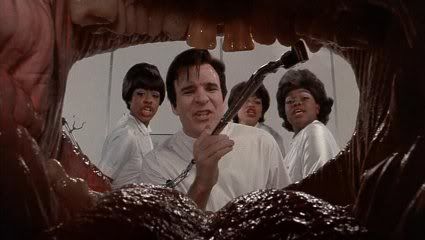
"Take a breath and look around. A lot of folks deserve to die." - AUDREY II, a carnivorous talking plant
Time for a moral self-inventory. What would you do for money? Fame? Love? All three at once? Think it over.
Let's say you lived in misery and poverty and were mocked and rejected on pretty much a daily basis. No one but no one respected you. Pity? Maybe. But respect? No. Let's also say that you were desperately in love with a co-worker who remained sadly out of your reach despite being just a few tantalizing feet away from you each day. Now let's further imagine that you stumbled across a miraculous solution to all your problems, a solution which unfortunately required you to kill a few people. Would you do it? Would you start murdering people? And would you commit further murders to cover up your earlier ones? After all, people are bound to start asking nosy questions...
Legendary B-movie screenwriter Charles B. Griffith seemed to think that, under those particular circumstances, a person of weak character might just become a killer, especially if the first few murders were more or less accidental and if the "victims" were largely unsympathetic. So in 1959, he wrote a cheap but effective little horror-comedy called A Bucket of Blood, in which a simpleminded schlemiel of a busboy (played by Dick Miller) stumbles first into killing and then into overnight success as a sculptor when he turns the corpses of his victims into "statues" by coating them with plaster and passing them off as works of art. The very next year, that film's director, Roger Corman, needed a script pronto in order to take advantage of some standing sets, so Griffith churned out a wackier variation on A Bucket of Blood, amping up the comedic and satiric elements, adding an absurd supernatural threat (a talking killer plant), and generally aiming for a freewheeling sketch-comedy/comic book feel, complete with silly names, throwaway gags, and wacky background signs. The resulting film, The Little Shop of Horrors, told the strange story of klutzy flower shop employee named Seymour (MST3K stalwart Jonathan Haze) whose apparent ticket out of Skid Row was a bloodthirsty talking plant, Audrey, Jr., who demanded human victims. In a way, the carnivorous plant of Little Shop was an even better metaphor for the vicissitudes of fame than the "statues" of Bucket of Blood. A plant, like fame, can either grow or wilt and must constantly be fed and tended to. In any event, Corman and Griffith's Little Shop had a shadowy half-life in the 1960s as the bottom half of a double bill with Mario Bava's Black Sunday but went on to be a perennial favorite at campuses and revival houses in the ensuing decades. Such was the film's enduring popularity that in 1982 -- twenty-two long years after its initial, ignoble release -- it became an off-Broadway musical by composer Alan Menken and lyricist Howard Ashman.
Nowadays, the idea of a stage musical based on an unlikely or semi-obscure movie, even a Grade-B horror film, is nothing special. In 2010, the American stage resembles nothing so much as a movie nerd's Netflix queue. Each year, dozens of such shows play here in Chicago, especially as we near Halloween. Back in '82, however, Little Shop was something of a freak occurrence. People weren't used to stage musicals based on faintly disreputable old movies. Reefer Madness: The Musical and its ilk were decades away. But Menken and Ashman's show had more than novelty appeal going for it. The songs were catchy and fun pastiches of early 1960s rock and soul, the staging incorporated some clever puppeteering, and the whole production had a spirit of infectious anarchy which set it apart from its off-Broadway competition. The show became an immediate hit, and a film version appeared inevitable. Originally, producer and music mogul David Geffen envisioned the film as a relatively inexpensive production, shot quickly for a few million bucks with Martin Scorsese (!?) directing. Somehow, though, the film morphed into an innovative and complicated $30-$40 million extravaganza shot on a huge soundstage at England's Pinewood Studios and helmed by the director of The Muppets Take Manhattan.
That's where I come in. I count Frank Oz's 1986 film version of Little Shop of Horrors as one of the defining movie-going experiences of my young life. I saw it when I was 11, and it captured my imagination as no film since Star Wars had. This was the first time I can remember actively lobbying my parents to buy me the soundtrack album for a movie, and I listened to that cassette dozens of times, memorizing each song until I could mime the lyrics perfectly. (Interestingly, during the film's difficult and drawn-out production, Oz also repeatedly listened to a tape of the soundtrack in order to motivate himself to continue with the cash-sucking boondoggle Little Shop had become.) It is little wonder that I had never seen anything like Little Shop before then. The live-action musical did not exactly thrive during the 1980s. Movies as diverse as Grease 2, Popeye, and Xanadu had met with chilly box-office and critical receptions early in the decade, and the already-antiquated genre was well-nigh extinct by '86, though Ashman and Menken would help to revive the animated musical as a viable commodity a few years later with The Little Mermaid. About the only things Little Shop had going for it from a marketing standpoint were the well-publicized appearances of several "guest stars" (Steve Martin, Bill Murray, John Candy) -- a point which the film's trailers and TV ads hammer away at -- and the fact that Hollywood was going through a full-fledged nostalgia boom thanks to the success of films like Back to the Future and Stand By Me. Is it mere coincidence that the songs from the stage show which did not make it into the movie, including "Mushnik & Son," "Closed for Renovations," and "Now It's Just the Gas," were the ones which did not really fit the rock 'n' roll oldies template? It's debatable.
In the end, neither celebrity cameos nor Kennedy-era nostalgia helped the film much at the box office. Although given a prominent Christmastime release by Warner Brothers (angling perhaps for some Oscar nods), Little Shop of Horrors did not come close to turning a profit on its enormous initial investment during its rather brief theatrical run but made some of its money back on television and video. Like its Corman-directed ancestor, the would-be blockbuster instead became a cult favorite. If anything, the film helped raise the profile of the 1982 stage version and the 1960 original film. Community theater and high school productions of the former cropped up all over the country (there was even a storyline on the TV show Head of the Class in which the gifted students staged the play), while the latter -- having slipped into the public domain -- frequently turned up on local TV stations and was released countless times on VHS and DVD.
But what of that troubled, semi-neglected 1986 version, the nominal subject of this article? How does it hold up in 2010? In my opinion, brilliantly. For me, writing these articles generally involves watching each film several times through and reading up on the film's background, and rarely has that process been more enjoyable than with Little Shop of Horrors. I have also used this as an opportunity to revisit the soundtrack albums of both the Off-Broadway show and the motion picture, and these have been just as delightful. What can I say? Sometimes when you re-watch a childhood favorite, you might still feel warm nostalgia for it as an adult but you can't help but notice the stilted plot, the wooden acting, the slightly cheesy production design, etc. But I felt none of these things with Little Shop, not even 24 years later. The jokes were still funny. The sets and costumes still looked great. (Oz's decision to film the entire thing inside a giant soundstage gives the whole movie the sense of "heightened reality" he was aiming for.) The puppeteering was still phenomenal. (Thank goodness this was made in the mid-1980s; today the plant would all but certainly be CGI.) The songs? Well, I think you can guess since I own two versions of the soundtrack...
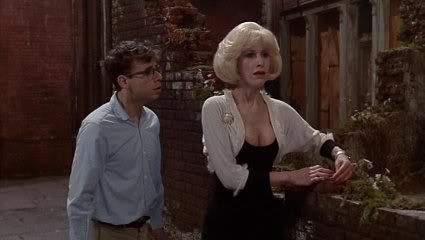
I will referain from making the rest of this review a laundry list of my favorite scenes, lines, and performances. No, I will not even mention the brilliant choreography and split-second timing Steve Martin -- so effective in this supporting role -- brings to the song "Dentist!" Or the way Rick Moranis and Ellen Greene manage to be cartoony and larger than life with their performances as (respectively) anti-hero Seymour and his objet d'amour Audrey, and yet somehow emerge as completely compelling, sweet and funny human beings. I will not even comment on the way Frank Oz ingeniously uses the musical's "Greek chorus" -- Crystal, Ronnette, and Chiffon -- who can turn up just about anywhere, in any guise to comment on the plot. It pains me not to mention them, especially since I still harbor a long-standing crush on Chiffon, played by the lovely and talented Tisha Campbell. (Martin wasn't good enough for you, honey!)
No, I won't talk about any of that. Instead, I'm going to focus on the film's highly controversial ending. In case you didn't know it, I'm a masochist. Throw me into the briar patch! I enjoy it! I think it goes without saying that the rest of my review is going to be spoiler-riffic... and not just for the '86 film but for the '60 one and the '82 musical as well. If you're squeamish about spoilers for a quarter-century old movie that didn't do well when it came out but which has played many times on television and which is probably available in 10-minute chunks on YouTube, then please turn around now. Skip down to Craig's review at least.
You still with me? Good.
So, anyway, that ending. The 1960 film progresses like this: Seymour winds up killing -- with varying degrees of intent -- several ancillary characters (a drunk, a hooker, a mean dentist) and feeding them to the plant, and his grouchy boss Mr. Mushnik feeds a grungy, pistol-packing thief (played by Chuck Griffith himself!) to the plant as well. But before the climax, nobody "important" dies -- not even greedy, unprincipled Mushnik or Seymour's hypochondriac mother (who is written out of all subsequent versions of Little Shop). Only after Seymour's crimes are discovered and he is chased around by some Dragnet-type police officers does the young man finally climb inside the plant to his death. Some critics have called Seymour's death a suicide, but I think he fully intends to kill the plant and somehow survive. The bottom line is, Seymour pays for his crimes in a manner befitting the protagonist of a pulp horror story: he creates a monster, and the monster destroys him. Somehow, in low-budget films of this vintage and genre, a downbeat ending is kind of a requirement. An optimistic ending would have felt completely false for this film. This version of Seymour, quite frankly, has to die. You see this kind of thinking a lot in horror comics of the 1950s. The characters are allowed to do all sorts of terrible, immoral things, but only if there's a "moral" conclusion. (See also: pretty much every episode of the Tales from the Crypt TV show.)
The 1982 stage musical of Little Shop, however, was its own entity. Here was a chance to end the story any way the authors saw fit. Weirdly -- and bravely -- Ashman and Menken's version amplifies the tragedy of the story. Seymour is again doomed, and Mushnik's luck runs out in this version. The most shocking change is that the story's most vulnerable, innocent character, the human Audrey whom Seymour loves, also dies. While the audience is still processing the cruel fate of Audrey, the show gives us a final nasty surprise: the victorious killer plant embarks upon a quest of world conquest and meets with much initial success. (The lyrics of the closing number, "Don't Feed the Plant," offer some vague hope for humanity but not much.) I have called the musical both weird and brave, which it is, but I have neglected to tell you one thing: the second half of the show is a real downer. The stage Little Shop is divided into two acts, and pretty much everything fun happens in Act I. Aside from the ballad "Suddenly Seymour," Act II grows darker and more somber -- never completely serious, mind you, but no longer giddy -- and even the songs get less and less catchy.
Director Frank Oz found out the hard way that Act II of Little Shop was, in his words, "not translatable" to the screen. After some disastrous test screenings, the last half hour of the movie version was radically revised to give audiences the "happy" ending they wanted. Gone were Seymour and Audrey's deaths, and gone too was the vegetable holocaust of planet Earth. In their place were some newly-shot scenes in which Seymour manages to defeat the plant by electrocuting it and then lives happily ever after with Audrey in the suburbs. The notorious original ending was only briefly made available on DVD before being yanked, but the footage is not too terribly difficult to find these days. Reader, I want you to do something for me. I want you to stop reading this article for a moment and do an internet search for "little shop of horrors original ending." I think you'll find the footage pretty easily. Once you find it, I want you to watch that original "dark" ending all the way through and then come back to this article. Can you do that for me? I'll wait.
Okay, are you back?
I know, I know, the only available copy is in black and white, and the music and effects aren't 100% done. But you get the general idea.
So what did you think? Was this ending better or worse than the one that actually wound up being released? I know as a good cinephile, I should be repulsed by the idea of a movie being changed to suit some dumb focus group. The masses are asses, right? Films should always honor the writer's original vision, even if it's dark and troubling and uncommercial. The previous versions of Little Shop had downbeat endings, as did their cinematic granddaddy Bucket of Blood. Why should the 1986 film be any different? It's a sellout. It's an abomination. It's a miscarriage of justice.
I know I should feel all of these things. And yet... I don't. I've watched the original ending many times, and I just don't care for it. The "happy" ending is corny and feels tacked-on, but I actually prefer it. I know that if the dark ending had gone out with the film in '86, the 11-year-old version of me would have hated it. I never would have become a Little Shop fan. I was never cool with the death of Audrey. I can see why Seymour had to be punished, but why Audrey? Yeah, I know intellectually that innocent people are often collateral damage in tragedies, but Audrey's already been stomped-on so much by this point -- she is not only poor but is also the victim of domestic abuse -- that feeding her to a plant seems like "piling on." The movie actually turns really serious during this passage. Audrey's death and Seymour's subsequent suicide attempt are played for pathos -- and get it -- but it feels totally out of place with what's come before. The worst part about all of this is that it ruins the film's climactic number, "Mean Green Mother From Outer Space." Remember how I said the stage show didn't have many catchy songs in Act II? Well, the writers acknowledged that and wrote the biggest, catchiest song of them all for the climax of the movie -- the one that got released as a single, the one that got the Oscar nomination, the one that even got some MTV airplay. "Mean Green" exists in both the upbeat and downbeat versions of the film, but the context is entirely different. In the upbeat ending, the song plays as I think it was intended -- as a rollicking comedy number, a crowd-pleaser, a foot-stomper. The puppeteering is more impressive here than anywhere else in the film. It's a showstopper. In the dark version of the film, "Mean Green" is almost identical but it comes right on the heels of a scene in which lovable Seymour has just fed lovable Audrey's corpse to the no-longer-lovable plant. Under these circumstances, "Mean Green" would have played to appalled silence from most audiences. It's terrible timing to have a rousing gospel song -- with some Bo Diddley thrown in -- at this point in the narrative. But without it, the last half hour would be even more of a drag. It's a tough call, but I'm going to have to side with that focus group.
I feel sleazy for saying that. Forgive.
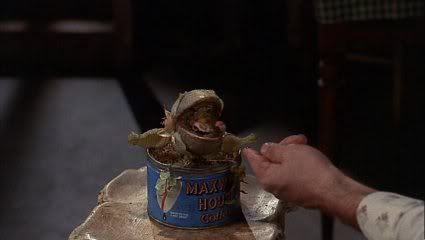
You are forgiven, Joe. But don't think for a second that I won't bring this up at the next Mid-West Cinephile Consortium. It's my duty.
Anyway, when Little Shop of Horrors first appeared in 1986, I had no idea it had such a complicated backstory. The original Roger Corman quickie was completely unknown to me at the time (it may have been in the public domain, but I didn't come across it until years later), and I was doubly unaware that it had been adapted into an off-Broadway musical. All I knew was it was a comedy about a man-eating plant that starred Rick Moranis (of Strange Brew and Ghostbusters fame) and featured cameos by funny people like John Candy, Steve Martin and Bill Murray. (Christopher Guest had yet to appear on my cultural radar and James Belushi was somebody I could either take or leave. Even at the tender age of 13 I recognized he was no substitute for his deceased older brother.) Beyond that, it may not have even registered that the film's director was Frank Oz, whose credentials as a puppeteer likely convinced producer David Geffen to give him the job, but this was the first time he took the reins of a project and stayed resolutely behind the camera.
In a lot of ways, the seeds of Oz's future directing career were planted by his experiences during the making of Little Shop. On the DVD commentary he makes repeated references to how he planned out each sequence up to a year in advance (sometimes timing things to the second) and burned through a lot of film stock to get the performances he wanted from his actors and technicians. That more than anything else may have influenced his decision to shun special effects-laden extravaganzas for the next few years and instead focus his energies on breezy, star-driven comedies like Dirty Rotten Scoundrels (which has itself been turned into a Broadway musical and will probably make it back to the screen at some point), What About Bob? and HouseSitter. Also, the test-screening process may have irked him to a degree ("We're a slave to the audience," he says at one point) and the happy ending mandated by it may have violated his artistic sensibilities ("As hokey as it sounds, that's what the audience wanted."), but Oz continues to use it to this day and, as a result, wound up doing extensive reshoots on his 2004 remake of The Stepford Wives (which, in a virtual replay of the fate of Little Shop's expensive "Don't Feed the Plants" finale, lost its most involved special-effects sequence when test audiences flat-out rejected it).
What's most surprising in all this is the fact that after such a labor-intensive, protracted shoot (six months according to Oz, which is a far cry from the two days it took Corman to get his version in the can) Little Shop still has a great deal of energy and vitality when it seems like it should feel forced and artificial. This is most impressive when one considers it was shot entirely on the 007 Stage at Pinewood Studios, where set designers had to build Skid Row from the ground up, even going so far as to import vintage New York City trash cans. (Of course, as regular readers of this series already know, this is hardly the first time this sort of thing has happened.) We get some of the flavor of the street setting during the catchy title song, but it's really brought to the fore in "Skid Row (Downtown)," which firmly establishes the oppressive atmosphere that pervades the place. And thanks to the forceful performances of the street's residents (some of whom come off as a little angry, even), it amply illustrates why anybody would want to get out of there.
For Seymour Krelborn (Moranis, essentially reprising his role as the nebbishy Louis Tully), his ticket out comes in the form of an unusual plant he finds in Chinatown (which is also where Hoyt Axton bought Gizmo in Gremlins, remember) that boosts business at the Skid Row flower shop where he works for the cantankerous Mr. Mushnik (the aptly named Vincent Gardenia) and pines for his unattainable co-worker Audrey (Ellen Greene, the lone holdover from the off-Broadway cast). He even names his mystery plant Audrey II after her, which would be a very sweet gesture if it weren't for the fact that it's a ravenous bloodsucker from outer space bent on world domination. But that's getting ahead of the story.
At first, Seymour is able to keep Audrey II alive with his own blood, but that's a short-term solution at best since the plant grows after each feeding -- and so does its appetite. Meanwhile, Greene gets her first standout moment as Audrey sings the yearning ballad "Somewhere That's Green" which is inspired by her flipping through a copy of Better Homes and Gardens. Her vision of a better life is the ultimate suburban consumer fantasy (she even sings about "plastic on the furniture to keep it neat and clean"), but she feels she has to defer her dreams because she doesn't deserve a nice guy. Now, the film never goes into what she did in her former life that was so terrible, but whatever it was she absolutely doesn't deserve to be a punching bag for a sadistic, nitrous oxide-addicted dentist (Martin, who's credited with a "special appearance" since he only gets about 15 minutes of screen time, but even that took six weeks to film according to Oz). No wonder Seymour decides to make him his first victim (with a little prodding from Audrey II, who's authoritatively voiced by Levi Stubbs of the Four Tops fame).
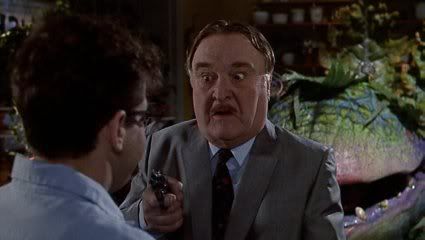
Joe briefly mentioned the celebrity cameos, but it's worth taking a moment to ponder what they added (or didn't, in the case of James Belushi) to the film comically. Up first, appropriately enough, is Christopher Guest as the all-important first customer who notices Audrey II in the flower shop window and winds up spending $100 (which would have been quite an outlay in the early '60s, when the film is set). On the commentary Oz mentions that Guest delivered his lines very naturalistically when he first arrived on set, but modulated his performance accordingly after he saw where Moranis, Greene and Gardenia were pitching theirs. ("It's meant to be bold, it's meant to be unsubtle," Oz says elsewhere about the film in general, and that applies equally to the acting.) In contrast, John Candy required no such prodding for his turn as the hyper-enthusiastic radio DJ who interviews Seymour about his plant while it's still small enough to be carried around. Candy was also one of the few actors who was allowed to go off script and ad-lib to his heart's content, and the same went for Bill Murray as the giddy masochist who loves pain so much that he creeps Martin's sadistic dentist out. He doesn't even blanch when Martin starts rifling through a collection of surgical tools that resembles nothing less than Beverly Mantle's "gynecological instruments for operating on mutant women" from David Cronenberg's Dead Ringers.
So anyway, back to the story, Martin is dispatched in a way that isn't really Seymour's fault (so our hero can retain some of his nobility) and, because Audrey II isn't large enough to eat anyone whole yet, the poor schmoe has to chop the abusive dentist up into little pieces and feed them to the plant. This is witnessed by Mr. Mushnik, who is torn between his first impulse, which is to turn Seymour in to the police, and his love of making money, which the shop has been doing hand over fist since Audrey II's arrival. Greed wins out in the end, naturally, which spells Mushnik's doom since he's the plant's next victim, and Audrey looks set to be the third until Seymour intervenes, thus setting up the climactic confrontation between animal and vegetable.
With all this talk of blood and killing and dismemberment and so forth, you'd think Little Shop would be a lot more gruesome than it is, but Oz deliberately downplays that aspect of the story. We only really see blood in the scene where Seymour pricks his finger ("Damn roses, damn thorns.") and discovers that's what Audrey II craves. As for the dismembering, we only get to see it in shadow, like something out of a William Castle movie from the '60s. Oz even mentions that he had the prop department make lifelike body parts for Seymour to feed to the plant (including Steve Martin's head, which must have been a sight) and ultimately decided not to use them. Instead, Moranis brings them in already wrapped in newspaper (which is dry as a bone) and stuffs them into Audrey II's eager mouth in such a way that we can't see anything. And the rows of nasty-looking teeth inside Audrey II's mouth are apparently for show because when Seymour pulls Audrey out she doesn't have so much as a mark on her. (This was even the case in the original ending where she dies in his arms.) Finally, when Seymour electrocutes Audrey II and the plant is blown to smithereens, you'd think there would be plant guts all over the place, but there are none to be seen. Either the filmmakers didn't want it to look like they were lifting the climax of Ghostbusters wholesale or they just didn't want to spend the extra money to splatter the set (and the actors) with sticky goop. At that point in the process, who can blame them for being a little exhausted?
In the final analysis, Little Shop of Horrors isn't very horrifying, but then again neither was Roger Corman's original, which augmented its main storyline with vaudeville-like routines involving Seymour's hypochondriac mother, Dick Miller as a gourmet flower-eater, and a pair of hard-boiled cops doing a dead-on Dragnet parody. All of those elements fell by the wayside in the transition to the stage and Howard Ashman obviously didn't feel the need to reinstate them when he adapted his book for the screen, which is just fine. That just leaves more time for Seymour and Audrey's burgeoning relationship and all the songs Ashman and Menken can shoehorn in, including my longtime favorite "Dentist!" I'm sure that went a long way toward erasing Steve Martin's unfortunate rendition of "Maxwell's Silver Hammer" (from the woefully misbegotten Sgt. Pepper's Lonely Heart Club Band movie) from people's memories. Oh, sorry, Steve.
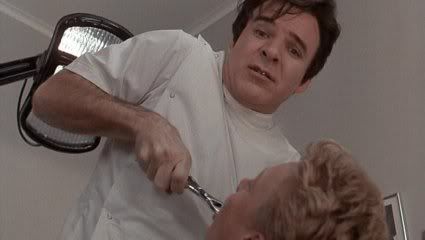
Up Next: We bear witness to a love triangle between repugnant magazine editor, an ambitious science journalist and a dude who slowly turns into a fly. Be there!

Good stuff. I'm still very fond of this, myself, as my high school executed a very fine production of it (with the actual Broadway plant) back in the late '80s. I was involved on the technical side of things and associate LSoH with a very merry period of my youth, so it's nice that it still holds up.
I, too, love the soundtrack; though I found the CD version I bought many years ago to be lacking in presence. I've long wished for a remastered version that had more "punch" to it, like an LP cut hot, back in the day. It seems no matter how high I turn the volume, it still sounds kind of thin. I forget if it was one of the early "DDD" releases -- many of those had issues, if I recall, as pure digital production was still fairly new.